Yoga Breakdown: Sun Salutations
Surrounded by regular practitioners in the studio setting, learning the elements of yoga for the first time, can be a daunting endeavor. Beginners often find themselves racing to “stick” the cued asana only to find that class is already moving on. Gaining insight to the sequences and your physical abilities prior to a studio excursion can lessen frustration and allow you to mindfully engage in the subtleties of a greater holistic practice. More than physically moving our bodies through space, meditation techniques create structured guidelines that assist us in getting out of our heads and involved in the present moment. Before we breakdown sun salutations, what follows is a brief introduction to some the techniques that will take a beginning practice to the next level.
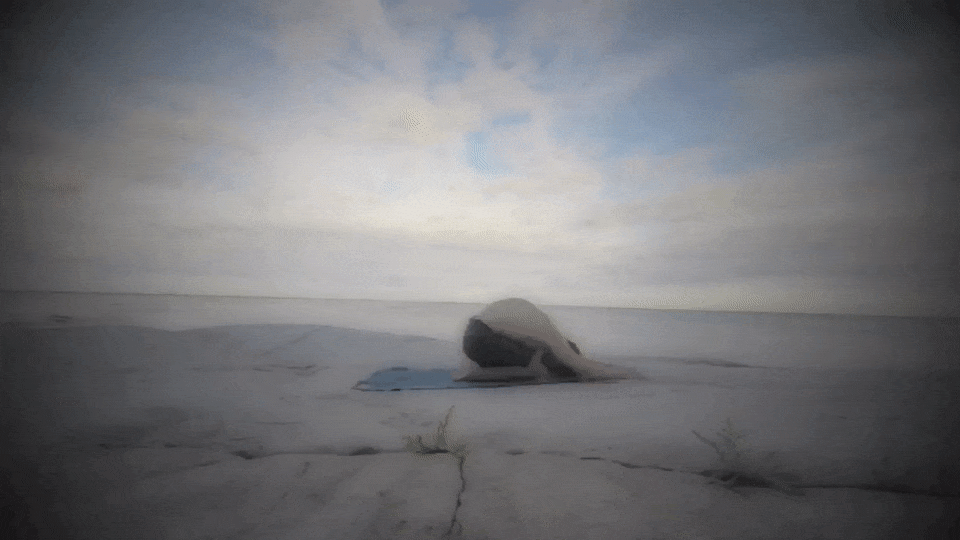
Breathing
Pranayama or breath control, is the meditation practice of consciously breathing. Focusing on your breath in and of itself, adds an element of concentration to your practice. Syncing your breath with movement takes it deeper. Combining your breath and movement with others to the cues of an instructor delves deeper still. Breathing in yoga is different than when lifting weights. In weightlifting, the practitioner exhales as they exert themselves while moving either the weight or themselves against gravity; in yoga, the practitioner exhales with gravity as they fold or lower themselves and inhale as they lengthen or rise. Exhaling as you fold allows to go deeper into the stretch of a posture and inhaling as you rise creates a floating feeling that as your lungs fill, will help raise and straighten your body. In addition, a specific type of modulated breathing, known as Ujjayi, can serve as another point which to meditate upon. Ujjayi breathing is performed with long and smooth breathes that resonate.
Physical
Body alingment is physical practice of appropriately positioning yourself in regards to a given posture. What is appropriate for some may not be appropriate for others; the challenge is to align yourself based on your ability and yours alone. The act of contracting and relaxing your muscles at will is known as muscular control; it is what drives you towards your best alignment. Muscular control not only determines the intensity of your workout but how deep you will be able to properly align yourself. Vigilance in directing your attention to the rhythm of the movement patterns takes alignment, control, and breathing a step further. Every subtle physical change through the course of a routine has a butterfly-like effect that challenges you to shift your focus in order to maintain speed in the present.
Mantras
Though mantras are historically religious in nature, they do not have to be for the purpose of meditation in yoga. “Mantras are used anchors for our wandering minds.” Some common mantras may include positive affirmations or prayer. Mantras may be long or as short as a single repeated word. Spoken aloud or internally recognized, any verbiage will do, so long as it necessitates additional attention to maintain focus upon.
The collective sum of these concentrations is a complex and ever challenging meditation. Each element added to your practice takes you further (ebb) from your ego and brings you closer (flow) to a more complete immersion in presence.
SUN SALUTATION BREAKDOWN
Now that you have been introduced or reacquainted with the tools that lead towards a rewarding practice, it is time to breakdown the physical nature of yoga to which they can be applied. The Sun Salutation is the hub from which all other asanas ebb from and flow back to through the course of a traditional vinyasa practice. In a given class, you may be required to perform more than 30 repetitions to flow through all the elements of class. If your having trouble nailing Salutations, then the rest of the class is gong to be an uphill battle. The following is an illustrated breakdown of the essentials, that with regular practice, will become an effortless and integral component of your flow.
It should be noted that although there is no exact right way to do any particular pose, there are well known practices that will leave you vulnerable to injury. Even though the poses themselves are nothing more than stretching, calisthenics, and gymnastics, you should listen to your body and be safe. Muscles should feel nothing more than mild discomfort and joints should feel no pain at all through practice. Pushing past these indications does not make you stronger, fitter, or more flexible; it is the gateway to an appointment with your orthopedic surgeon and physical therapist. The strongest yoga practitioners are the ones who are tuned into their bodies and know when to say “when”. As your practice gains momentum, you will find that perhaps the biggest challenge is to back off and be content with what your current physiology allows.
Child's Pose
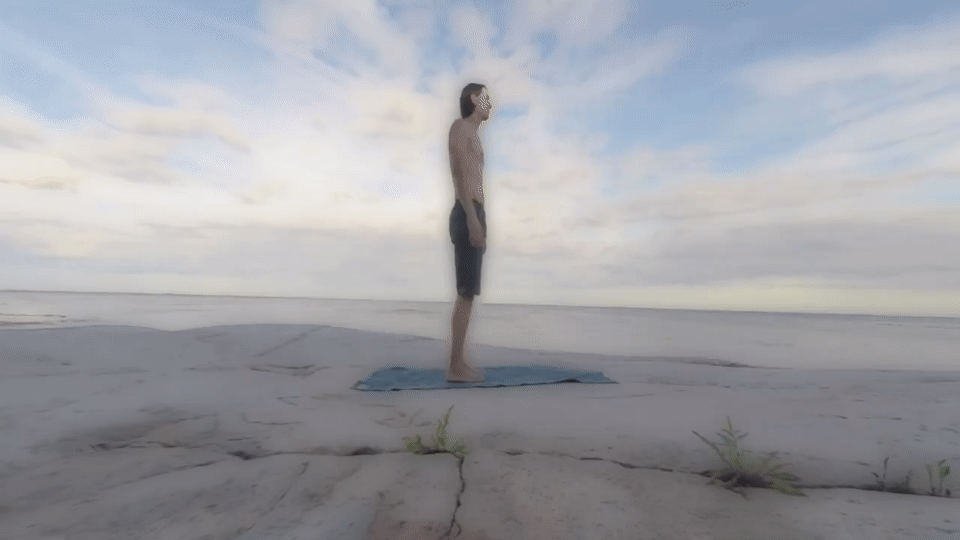
Child’s Pose is an asana that stretches the tibialis, quadriceps, hips, lower back muscles. Sit back on your heels with the top of your feet facing down towards the mat. Bring your abdomen and chest down towards your thighs. Extend your arms forwards or bind them in a variation. Beginners may find it challenging or impossible to close the space between their hind quarters and heels; that is okay. Move to where your body allows and let gravity do the work for you. As your practice progresses you will find yourself moving deeper into the pose. Child’s Pose is an excellent position to revert to for a moment to collect yourself during class when other poses are too challenging or when your fitness requires you to take a moment of rest. In addition, this may be one of the simplest techniques I’ve used over the years in helping clients alleviate back pain.
Cat/Cow
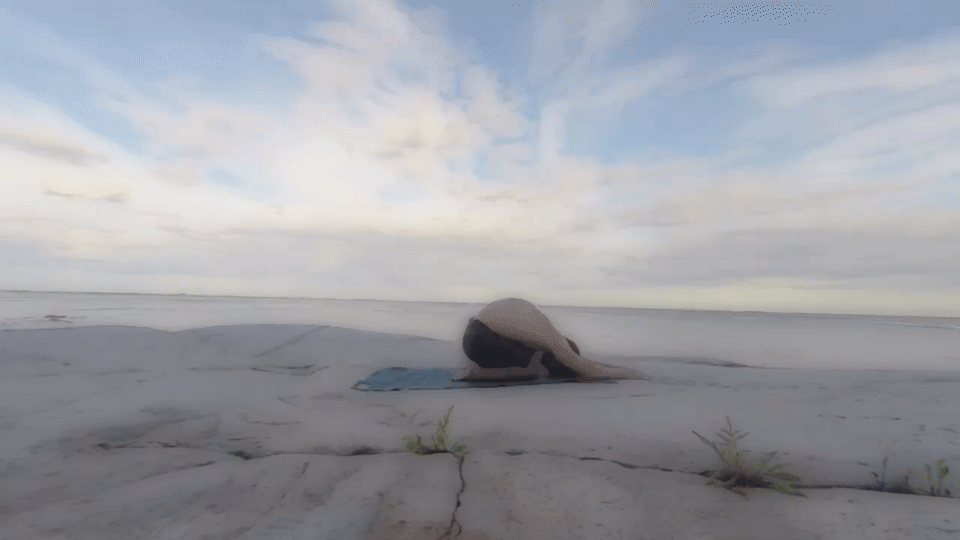
Cat is more often than not paired with cow as they are complementary asanas. Cat stretches a good portion of the posterior chain of the body (that includes the back and neck muscles) while cow stretches the anterior chain (abdomen, upper front torso, and neck). Cat is performed by starting with a flat back in tabletop position. Exhale and arch the back upwards while directing your chin towards your chest. Cow is performed from the same position, but the action is opposite; inhale and sink the abdomen down towards your mat by aligning your head position with a comfortable upward gaze.
Down Dog
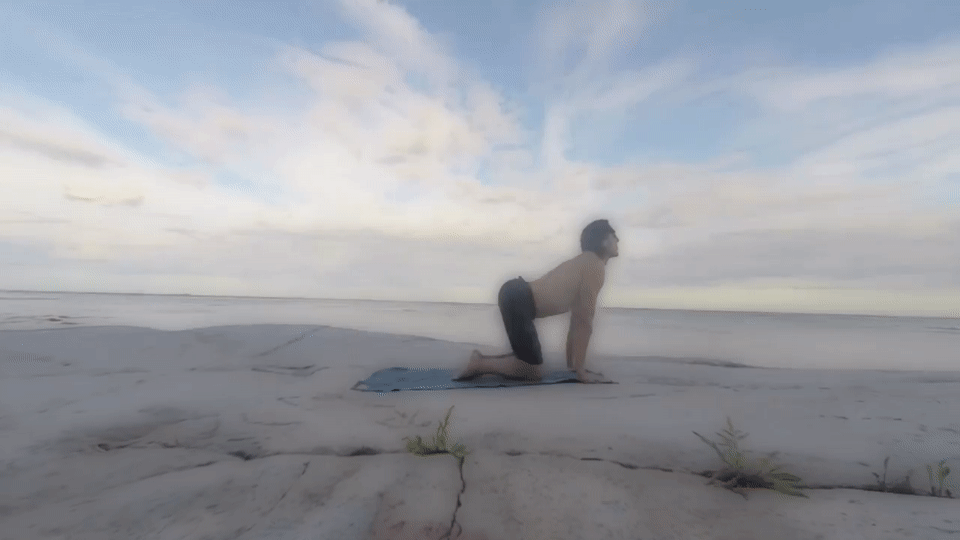
Down Dog stretches the hamstrings, shoulders, calves, feet, and back while strengthening the arms, shoulders, and legs. Exhale as you drive your hips back and up. The goal is to create the shape shape of a slightly skewed triangle while focusing your efforts to create a straight line between your hands and tailbone. Fingers should face forward and the outer elbows drawn down towards the mat. Based on the practitioners flexibility, there are a number ways to execute the leg portion of this pose. Some focus on closing the space between their thighs and abdomen to better align their upper body. Others focus on straightening the legs to stretch the hamstrings. In both cases, you will also see varying degrees as to how close the practitioners heel meets the mat. Focus your gaze towards your navel. Lengthening the space between between the hands and feet is also another opportunity for challenge and play within the pose. Down Dog is considered a mild inversion and as a result is a great way to the build the strength and endurance required to perform more advanced arm balances/inversions.
Jump Sequence
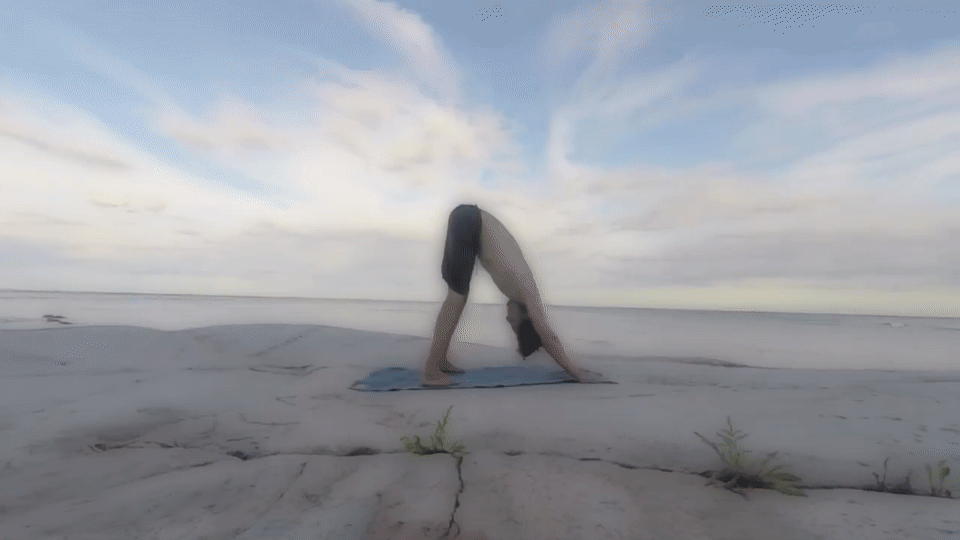
The Jump Sequence is the transitional move that takes you from Down Dog to Half Lift. There is a requisite amount of flexibility and strength required that some beginners may not possess, but there are other options to get you to the front of your mat. The first is to lunge forward one leg at a time. Second, is to simply step/tip toe forward. Finally, you can practice smaller jumps and then close the rest of the distance by stepping. With practice, you will soon be floating to the front of your mat with ease. The Half Lift is nothing more than a forward bend with your upper body parallel to the mat. Check to make sure you are not holding your breath and that you maintain a flat back (neutral spine) to alleviate any potential lower back strain.
Half Lift Transition
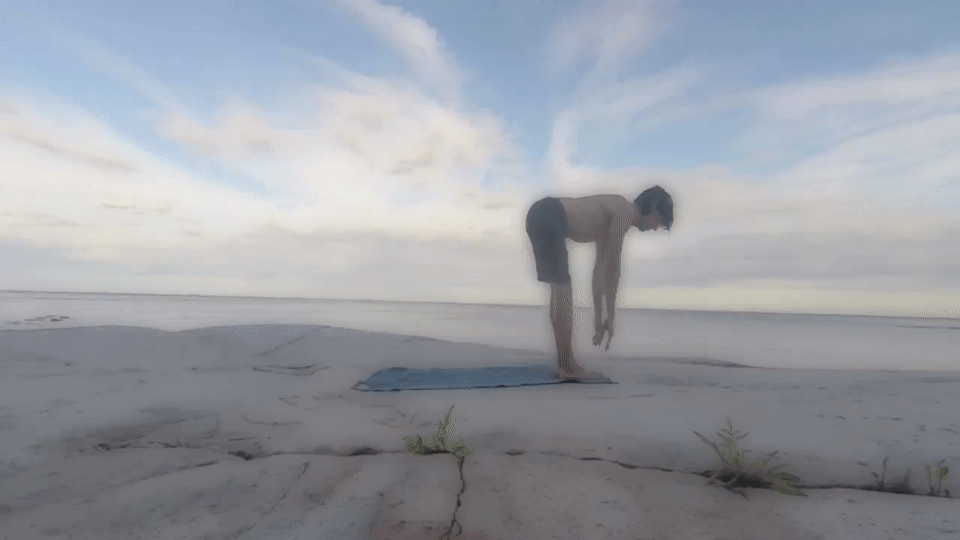
This second transitional sequence takes you from Half lift, down to Forward Bend, upright to Extended Mountain Pose, back down to Forward Bend, and returns you to Half Lift. Do not force Forward Bend; let gravity do the work for you. From Half Lift, exhale and fold at the hips. Allow your head to fall towards the mat closing the space between your chest and thighs. Legs should be straight and your gaze set towards your navel. Inhale as you rise up into Extended Mountain Pose. Arms may travel in whatever path best suits the health of your shoulders. Stretch up towards the sky. Exhale as you fold back down into Forward Bend. Inhale as you rise back into Half Lift.
Chattarunga
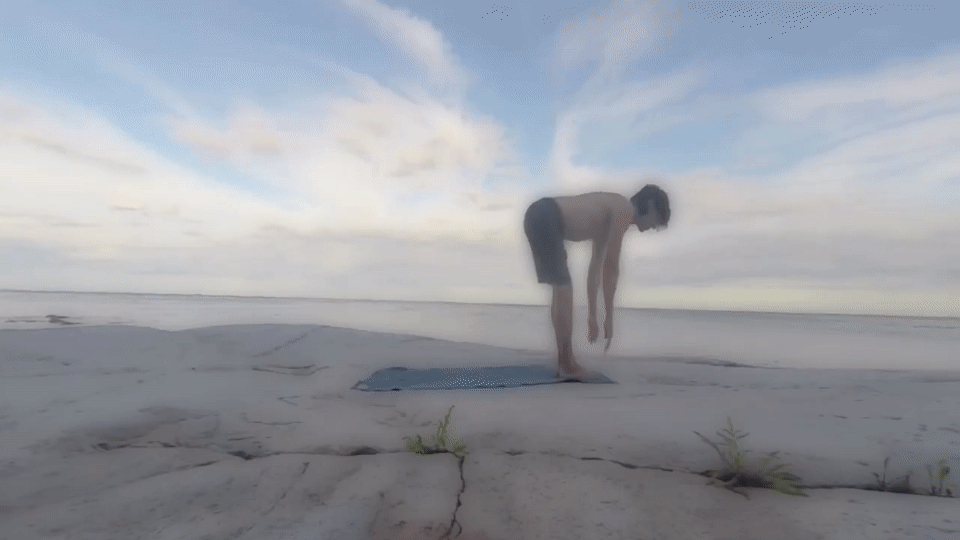
In SunSalutations, Chattarunga is the asana that takes you from Half Lift to Up Dog. This is undoubtedly the most physically challenging element; repeatedly done with poor form will put undo stress on the shoulders and lead to injury. If your fitness is not to where you can safely perform Chattarunga, then simply step or lunge back into high plank (top of the pushup position) and then lower yourself to the mat. It is essentially the reverse of Jumping Forward; so if you modified that portion of the sequence, then you will most likely need to modify here as well. Up Dog starts from the bottom of a pushup position. With tops of your feet down against the mat, extend your toes behind you. Inhale and drive your shoulders up by pushing your palms down into your mat. Push your chest out and pull your shoulders back. Un-shrug by creating space between shoulders and your ears. By flexing your glutes and lower back, you will find that you will be able to lift your knees and thighs off the mat. Up Dog strengthens the chest, shoulders, and triceps in addition to deeply stretching the hips and abdomen.
Asanas and Cues
In addition to learning the postures and movement patterns, it helps to become familiar with names of asanas and their cues. In some studios you may find that you will be able to get visual cues from the instructor as they practice with the class and cue the flow. In others, instead of going through the routine, the instructor may stand and watch from the front of the class or walk around. In that case, the instructor is calling out cues based on the group dynamic of breath and movement; a meditation upon your meditation so to speak. In either case, it is helpful to understand the cues, associated breath action, and the duration of each posture. Here is the breakdown for sun salutations from the start of a typical vinyasa class:
Cue / Breath / Duration
Childs Pose / start ujjayi breath / one to three minutes
Cow / inhale / one breath (cat /cow sequence may endure three to five repetitions)
Cat / exhale / one breath
Down Dog / exhale / three to five breaths
Jump or walk to the front of your mat / exhale / one breath
Half lift / inhale / one breath
Fold / exhale / one breath
Rise up / inhale / one breath
Fold / exhale / one breath
Half Lift / inhale / one breath
Chattarunga / exhale/ one breath
Up dog / inhale / one breath
Down dog / exhale / three to five breaths
Jump or walk to the front of your mat / exhale / one breath
Half lift / inhale / one breath
Fold / exhale / one breath
Rise up / inhale / one breath

By integrating the mental and physical practices of meditation to the score of the Sun Salutation, we find meditation in motion. In the scheme of things, it is a relatively easy sequence to become proficient in. What it does so effectively though, is provide a canvas for you to practice your art. Every mindful repetition deepens awareness and increases your physicality. Put the entire sequence into practice at your own pace for 3 to 5 repetitions as a start. Take your time and listen to your body.
I'm new to the steemit community, have a lot of content to provide, and if you found any value in this piece, then I'd really appreciate an upvote-thanks!
That was a wonderful breakdown of the techniques. I appreciate the time you put into this. Thank you. Be well.
Thank you.
This is a great post. How did you do those visuals - they are fabulous!!!! 'a canvas to practice your art' - love it. I really love moving slooowwwly through them and feeling subtle sensations in my body. It's also about neural programming - ah i have to go to work - no time to steem or salute! Looking forward to reading more of your posts. Resteeming this xx
Thank you! It's nothing more than an Iphone, Final Cut Pro X, and taking the time to figure out what you want to express. Glad you enjoyed it.
Congratulations @ebbandflowmotion! You have completed some achievement on Steemit and have been rewarded with new badge(s) :
Click on any badge to view your own Board of Honor on SteemitBoard.
For more information about SteemitBoard, click here
If you no longer want to receive notifications, reply to this comment with the word
STOP